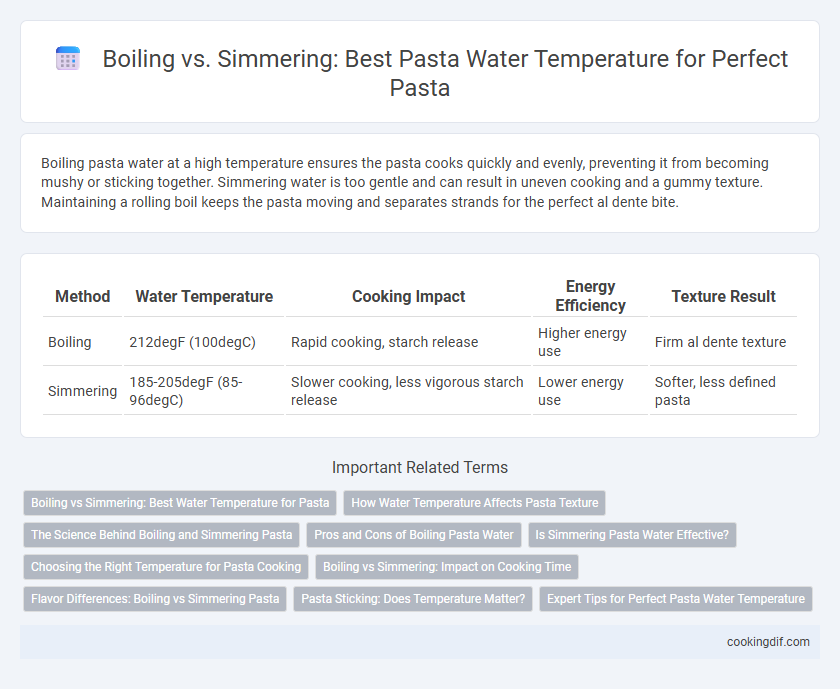Boiling pasta water at a high temperature ensures the pasta cooks quickly and evenly, preventing it from becoming mushy or sticking together. Simmering water is too gentle and can result in uneven cooking and a gummy texture. Maintaining a rolling boil keeps the pasta moving and separates strands for the perfect al dente bite.
Table of Comparison
| Method | Water Temperature | Cooking Impact | Energy Efficiency | Texture Result |
|---|---|---|---|---|
| Boiling | 212degF (100degC) | Rapid cooking, starch release | Higher energy use | Firm al dente texture |
| Simmering | 185-205degF (85-96degC) | Slower cooking, less vigorous starch release | Lower energy use | Softer, less defined pasta |
Boiling vs Simmering: Best Water Temperature for Pasta
Boiling water at 212degF (100degC) is ideal for cooking pasta as it ensures rapid heat transfer and prevents sticking by keeping the noodles moving. Simmering, typically between 185degF and 205degF (85degC to 96degC), can result in uneven cooking and a softer, less desirable texture. Maintaining a rolling boil preserves the pasta's firmness, crucial for al dente perfection favored in Italian cuisine.
How Water Temperature Affects Pasta Texture
Boiling pasta water at 212degF ensures rapid cooking and prevents noodles from sticking together by creating vigorous bubbles that circulate the pasta. Simmering water, typically around 185degF to 205degF, slows cooking significantly, potentially leading to uneven texture and mushiness as pasta absorbs water without firming up. Maintaining a rolling boil is crucial for achieving al dente pasta with a firm yet tender bite, optimizing starch gelatinization and preventing overcooking.
The Science Behind Boiling and Simmering Pasta
Boiling pasta at 100degC ensures rapid starch gelatinization and prevents noodles from sticking by maintaining turbulent water movement, while simmering around 85-95degC results in slower cooking and may produce uneven texture. The higher temperature of boiling increases molecular agitation, promoting consistent heat distribution and faster cooking times critical for al dente pasta. Scientific studies highlight that maintaining a vigorous boil preserves pasta's structural integrity, optimizing texture and preventing overcooking or mushiness common with simmering.
Pros and Cons of Boiling Pasta Water
Boiling pasta water at 212degF (100degC) ensures rapid cooking and helps pasta maintain a firm texture by preventing it from becoming mushy. However, boiling vigorously can cause pasta to stick together or break apart due to constant agitation from bubbling water. Simmering at lower temperatures reduces the risk of pasta sticking or tearing but can result in uneven cooking and longer preparation times.
Is Simmering Pasta Water Effective?
Simmering pasta water typically ranges between 185degF to 205degF (85degC to 96degC), which is lower than boiling at 212degF (100degC). While simmering can cook pasta gently, it often leads to uneven texture and longer cooking times compared to boiling. Boiling water ensures consistent heat and agitation, promoting even pasta cooking and optimal starch release for desired texture.
Choosing the Right Temperature for Pasta Cooking
Choosing the right water temperature for pasta cooking is essential to achieve the perfect texture and prevent sticking. Boiling water at 212degF (100degC) rapidly cooks pasta and keeps noodles separate, while simmering at lower temperatures (around 185-200degF or 85-93degC) can cause uneven cooking and mushiness. Maintaining a rolling boil ensures optimal starch release and firmness, enhancing both flavor and mouthfeel.
Boiling vs Simmering: Impact on Cooking Time
Boiling pasta at 212degF (100degC) rapidly cooks the noodles by maintaining a consistent high temperature, resulting in shorter cooking times and evenly cooked pasta. Simmering water, typically around 185degF to 205degF (85degC to 96degC), slows the cooking process, often extending the time needed and potentially leading to uneven textures. Optimal pasta cooking requires boiling water to ensure the starches gelatinize quickly, preserving the intended al dente firmness and preventing gummy or mushy outcomes.
Flavor Differences: Boiling vs Simmering Pasta
Boiling pasta ensures rapid cooking and prevents the pasta from becoming gummy by maintaining a consistent high temperature, which helps maximize the starch release and enhances the sauce's texture and flavor absorption. Simmering pasta at a lower temperature results in a softer, less al dente texture and can lead to uneven cooking, which may dilute the pasta's natural flavors and reduce overall dish quality. Maintaining a rolling boil preserves the pasta's structural integrity, enriching the final taste and mouthfeel compared to the subdued flavors developed when simmering.
Pasta Sticking: Does Temperature Matter?
Pasta sticking is significantly influenced by water temperature, with boiling water at 212degF (100degC) creating vigorous movement that prevents noodles from clumping. Simmering water below 205degF (96degC) lacks sufficient agitation, increasing the likelihood of pasta sticking together. Maintaining a rolling boil ensures optimal pasta separation and texture during cooking.
Expert Tips for Perfect Pasta Water Temperature
Expert tips for perfect pasta water temperature emphasize boiling water at 212degF (100degC) to ensure pasta cooks evenly and prevents sticking. Maintaining a rolling boil from the moment pasta is added preserves texture and prevents gummy results. Simmering water below boiling temperature often leads to uneven cooking and a mushy consistency.
boiling vs simmering for pasta water temperature Infographic

 cookingdif.com
cookingdif.com